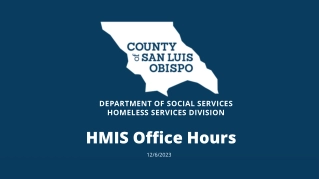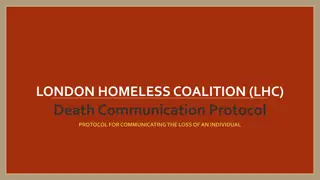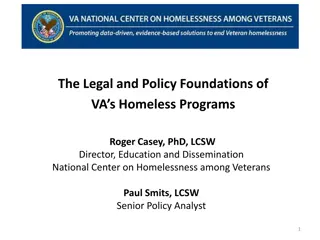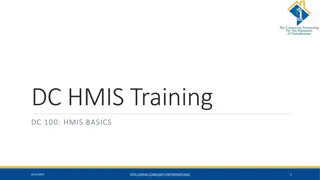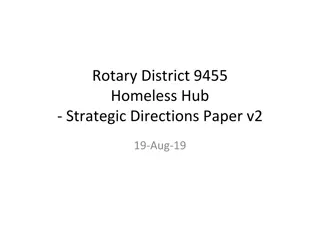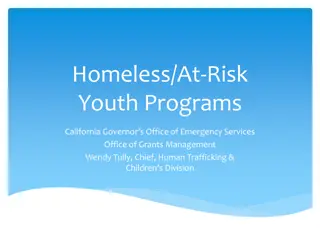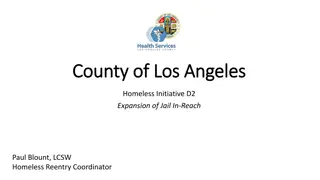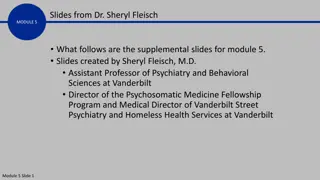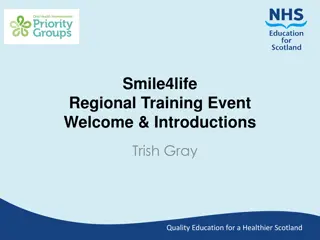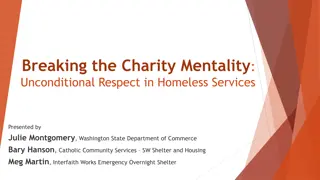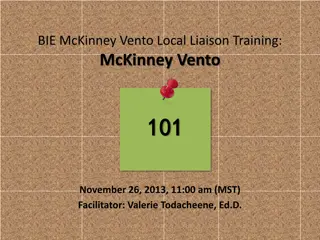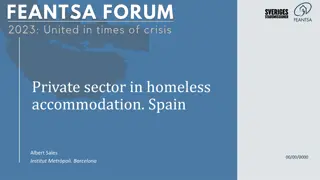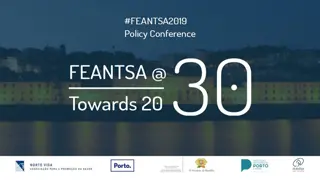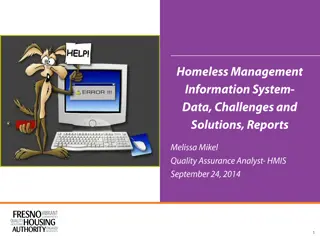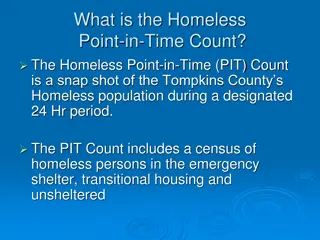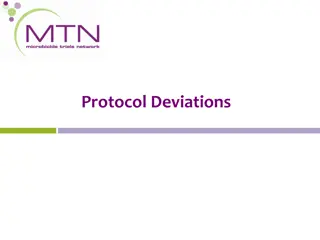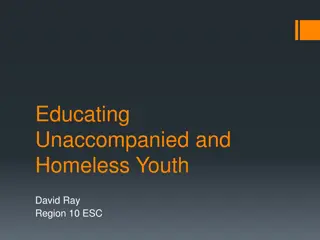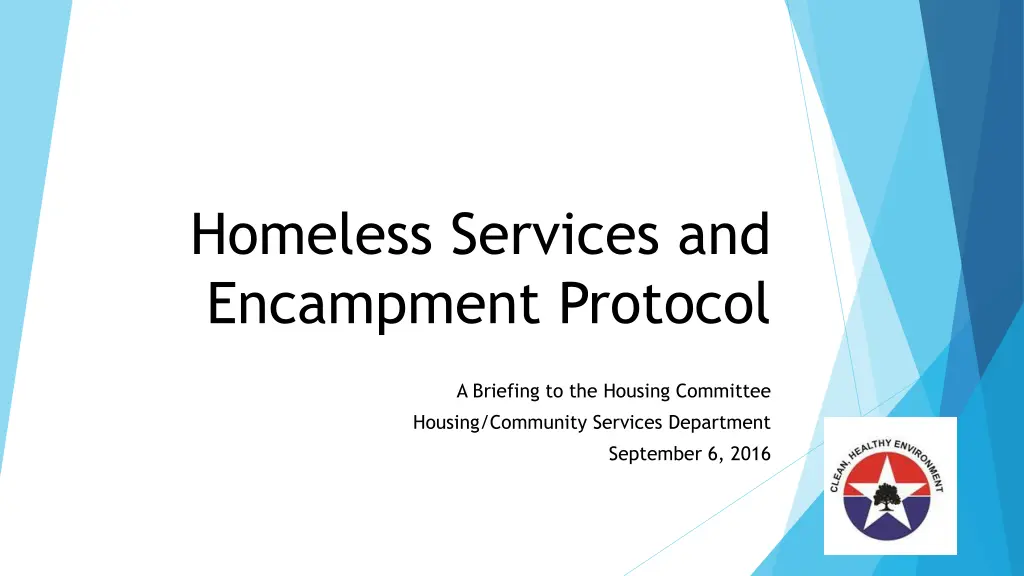
Dallas Homeless Services and Encampment Protocol Overview
"Learn about the City of Dallas Homeless Services Programs, funding sources, comprehensive outreach efforts, and partnerships to support individuals experiencing homelessness. Explore the encampment protocol and available resources for immediate needs."
Download Presentation

Please find below an Image/Link to download the presentation.
The content on the website is provided AS IS for your information and personal use only. It may not be sold, licensed, or shared on other websites without obtaining consent from the author. If you encounter any issues during the download, it is possible that the publisher has removed the file from their server.
You are allowed to download the files provided on this website for personal or commercial use, subject to the condition that they are used lawfully. All files are the property of their respective owners.
The content on the website is provided AS IS for your information and personal use only. It may not be sold, licensed, or shared on other websites without obtaining consent from the author.
E N D
Presentation Transcript
Homeless Services and Encampment Protocol A Briefing to the Housing Committee Housing/Community Services Department September 6, 2016
Purpose Provide information regarding the City of Dallas Homeless Services Programs Discuss Additional Resources for Immediate Needs Discuss Encampment Protocol 2
City of Dallas Homeless Services The Comprehensive Homeless Outreach Division has oversight of the City s supportive housing programs focused on persons experiencing homelessness or at risk of homelessness Comprehensive Homeless Outreach team is dedicated to following services: Intake and assessment of homeless Creation of housing/treatment plans with homeless Supportive services to locate housing, jobs, transportation, mental & behavioral health care to individuals and families Vouchers for rental assistance, including application fees & security deposits Client home visits (at least monthly) Landlord liasons Special services for those formerly incarcerated, seniors, and HIV/AIDS clients Emergency homeless prevention assistance Management of subrecipient contracts 3
Budgets & Funding Sources FY 15-16 Budget is $12,324,131 General Funds $6,193,230 Dallas County Funds $1,100,000 (pass through for the Bridge operations) Grant Funds $5,030,901 FY 16-17 Proposed Budget is $16,672,615 General Funds $7,141,767 Dallas County Funds $1,100,000 (pass through for the Bridge operations) Grant Funds $8,430,848 Note: City of Dallas contracts $3.8M of general funds for the Bridge operations 4
Grant Funds HUD Emergency Solutions Grant HUD Housing Opportunities for Persons with AIDS (HOPWA) Competitive Funds HUD Continuum of Care Funds for Rapid Rehousing & Permanent Supportive Housing Competitive Funds Texas Department of Housing & Community Affairs Department of State Health Services 5
Partners AIDS Services of Dallas Austin Street Shelter Bridge Steps CitySquare Dallas County Dallas Housing Authority Dallas Life Family Gateway Family Place Health Services of North Texas Homeward Bound Legacy Counseling Center Legal Aid of Northwest Texas Men of Nehemiah Metro Dallas Homeless Alliance Metrocare My Second Chance Open Arms Operation Relief Center Our Calling Parkland HOMES Salvation Army Shared Housing Turtle Creek Recovery Union Gospel Unlocking DOORS Veterans Affairs 6
Performance Metrics Emergency Solutions Grant Number of clients receiving case management Number of unduplicated homeless persons placed in housing Percent of clients staying in permanent supportive housing for seven (7) months or longer Continuum of Care Number of clients receiving case management Number of unduplicated homeless persons placed in housing Percent of clients staying in permanent supportive housing for seven (7) months or longer Housing Opportunities of Persons with AIDS Number of clients receiving case management Number of unduplicated homeless persons placed in housing 7
Immediate Needs for System Improvement Street Outreach Supportive Services & case management Housing Navigators Application fees, security deposits, other miscellaneous expenses Mental and Behavioral Health Care Respite Care Youth Services All service providers need a common data platform to share information Encampment Protocol 8
FY 16-17 Additional Resources from General Fund Hire additional case workers to cover functions of street outreach, supportive services & case management, and housing navigation Leveraged with County and State Resources Includes Mental & Behavioral Health Resources Provide flex funds to pay for transportation, identification materials, overnight stays (hotel, boarding home, shelter), application fees, security deposits, other expenses Utilize some funding for encampment clean-up and fencing (as needed) Note: See attachment A for Implementation Plan and Outputs and Impacts 9
FY 16-17 Additional Resources from State of Texas Department of State Health Services- Healthy Communities Collaborative (HCC) will provide $4.1M for agencies to provide: Street Outreach Mental Health and Substance Abuse/Detoxification Services Emergency Shelter Transitional and Permanent Housing Intensive Case management State funds must be matched dollar-for-dollar with private funds by the agencies 10
Questions 11
311 Calls Reported Encampments March- July 2016 13
Evaluation of All Reported Encampments DPD Crisis Intervention initially responds to 311 City of Dallas Emergency Service calls Crisis Intervention determines whether the encampment is situational or permanent Situational might be characterized by here one night and gone the next morning Permanent is characterized by the existence of free-standing structures, personal belongings, and other valuables If a permanent encampment is identified, the Crisis Team will attempt to outreach and assess the homeless persons The Crisis Team offers referrals, transportation to shelter, and warm handoff to mental health/substance abuse treatment Crisis has been primarily involved in providing Notices of Closure and Notices to Vacate when an encampment is being closed 14
Clean-up of Right of Way In the past, the Department of Street Services has had the responsibility of removing debris/litter from right-of-way using various methods: City Median Maintenance (via contractor) All median throughout the city have litter picked up in advance of mowing every 14 days Litter removal continues after the mowing season during the winter months as well TxDot Right of Way (via contractor) Al TxDOT ROW has litter removed every 28 days in advance of mowing Winter cycle is included Emergency Response (in-house) As debris/litter accumulates in the city ROW as poses a hazard to motorists Streets emergency crews will abate the hazards affecting traffic Over the years, due to the growth in permanent encampments, HAZMAT teams had to be engaged with additional expenses to the general fund 15
Departments Picking Up Trash, Litter, Debris Code Enforcement Illegal Dumping Parks Sanitation Residential and Commercial Customers Streets Trinity 16
Recap of I-45/I-30 Encampment Closure Site included five sections A-E Closure was performed in sections Approximate high point of 300 people Timeframe for actual closure was 45 days Comprehensive Assessment/Triage of the population Intensive Case Management Identified Resources Communications Planning Strived for a single coordinated message between tent city , service providers, neighborhoods, Police Department, City Officials, and other stakeholders No Trespassing signage throughout, Closure Notices weekly, Notice to Vacate a week before section closure Days of Closure Outreach workers and volunteers assisted persons with moving their items Patrol officers were present ensuring safety Cleanup began immediately after the site was vacated; fencing was complete by the end of the day to secure the site 17
Accomplishments Since Tent City Closure Creation of Permanent Street Outreach and Intensive Case Management Team 57 persons housed by City Square 4 moved outside of Dallas 13 persons in emergency shelter 2 persons housed by Metrocare Services 2 persons to private permanent housing 18 fully assessed and prioritized on housing priority list Dashboard of all known encampments through 311/911 calls Closure of Coombs encampment in July 2016 Tracking of Harwood and Haskell encampments Noting the health and safety concerns and number of tents 18
Encampment Closure Proposed Policy 1. Site Assessment Review by a Team 2. Recommend Closure Plan 3. Implement the Encampment Closure Plan 19
Site Assessment Review Encampment Information Reviewed by Team of City of Dallas and Continuum of Care leadership 311/911 calls Evidence & documentation of significant public safety concerns Map and characteristics of the site (e.g. Is this public property?) Population count and basic needs assessment 20
Recommend Closure Plan Closure Plan details will include: Resources required for supportive services to persons in the encampment 1 full time case manager for every 10 households Viable placement options (i.e. shelter, treatment centers, housing) Resources required for site clean-up Placement of trash receptacles Determine whether to contract clean-up in advance of closure Timeline for closure, including when signage is posted and notices are distributed Legal Review 21
Implement the Plan Trespassing signs posted Initial closure notices distributed by the City and weekly until closure Blitz assessments by street outreach team Weekly case management staffing Weekly meetings with the closure team Notices to vacate 4-5 days before closure On close date, case managers, DPD, Sanitation, Streets, Housing/Community Service staff on hand to manage site and homeless people Housing/Community Services orders clean-up and possibly fencing for the date of closure 22
Attachment A Implementation of City of Dallas Expanded Homeless Initiative 23
Implementation of City of Dallas Expanded Homeless Initiative Funding - $1,000,000 Budget Enhancement $1 Mill 312 Unduplicated Households Q2 Q3 Q4 Projected Annualized Outputs and Impacts Accountability Performance Metrics Q1 Street Outreach, DHA and Shelter Based Supportive Services Oct 1 Dec 31 Q1 Report Jan 25 Jan 1 March 302 Q2 Report April 25 April 1 June 30 Q3 Report July 25 July 1 Sept 30 Preliminary Final report Aug 25 Outputs recorded in HMIS Monthly Dashboard Reporting Budget Items: -Complete Hiring -Staff training on HMIS, Coordinated Assessment System (CAS) -Comprehensive encampment data secured for January Point in Time Count -Complete unsheltered client by- name list in HMIS integrated with Coordinated Assessment Housing Priority List (Including Vets, Chronic) -Encampment Assessments -Effectively end unsheltered Veteran homelessness -Reduce Chronic Unsheltered and Emergency Homelessness by another 10% 4 Case Managers maintain 10 household caseloads with average engagement time frame of 45 days -Number of contacts, engagements and enrollments in Street Outreach (MDHA HMIS) 8 City of Dallas positions: - 1 Program Supervisor - 1 Admin - 2 Street Outreach Case Managers - 2 Shelter Based Housing Navigators - 2 Tenant-Based Case Managers supporting DHA Vouchers -Reduce Chronic Unsheltered and Emergency Sheltered homelessness by 10% -Begin interagency staffing with Street Outreach Committee with partners (MDHA, CitySquare, MetroCare, Crisis Intervention and Emergency Shelters -Encampment Assessments -Exits to ES, TH, RRH or PH (MDHA HMIS) 2 Tenant Based Case Manager with 36 household caseload -Up to three Encampment Closures as protocol allows -By-name list and CAS housing reports (MDHA CAS) -Encampment Assessments -240 Engagements Supplies, transportation, equipment, cell phone, mileage -Up to three Encampment Closures as encampment protocol allows - 180 Direct Services Provided -Critical Documents and direct client services secured (COD/MDHA) -Six Interagency client staffing meetings -Finalization of Encampment Closures Policy -Up to three Encampment Closures as encampment protocol allows Direct Client Services Birth Certificates, IDs, Transportation, Moving costs (application fees, security deposits, risk fees, relocations), and other flex fund costs. -135 Exits from Unsheltered Street Outreach -House 10 DHA Households -Income and Benefit Changes (MDHA HMIS) -Encampment Assessments -Six Interagency client staffing meetings -Point in Time Count Complete -Six Interagency client staffing meetings - 96 Exits from Emergency Shelter -Housing navigation and placement 24 ES households -Two encampments closures - Six Interagency Staffing meetings -Housing navigation and placement 24 ES households -311 calls Analysis (COD) Emergency Hotel stay for households -House 10 DHA Households -Housing navigation and placement 24 ES households -65 emergency hotel stays - Eleven Encampment closures - House 10 DHA households -Housing navigation and placement 24 ES households -911 calls Analysis (COD) Expanded materials for encampment clean-up -Encampment Map Update (COD) 24
Attachment B Dallas Commission on Homeless Subcommittee Recommended Protocol 25
Evaluation and Action Guidelines for Clearing Homeless Encampment June 20, 2016 Cindy J. Crain, CEO and President Metro Dallas Homeless Alliance This document has been reviewed and amended in consultation with the Dallas Commission on Homelessness Unsheltered Homeless Subcommittee on June 20, 2016. These guidelines detail the proposed process for evaluation and appropriate action in response to an encampment of persons experiencing homelessness within the Dallas city limits. The guidelines are developed to establish cooperative responses to unsheltered homeless by city officials and the emergency homeless response system. These guidelines are built with the acknowledgment that the experience of extreme poverty and associated housing barriers is the contributing factor to a person spending the night in an outdoor place not meant for human habitation. The subjects of encampment clearing decisions will meet the HUD definition of unsheltered homelessness. The basis of these guidelines is to, at every possible stage, respond first and foremost to addressing the extreme poverty and homelessness condition that has resulted in a concentrated area presenting with serious observable threats to public health and safety. Identification of Encampment Site for Evaluation for Clearing The City of Dallas 311 system currently is used to identify concerns and locations related to unsheltered homeless. These calls are typically routed to the Dallas Police Department Crisis Intervention Unit following existing protocols (See attached CIU Operational protocol). Each occasion is triaged with available resources to resolve the complaint. When a location begins to exhibit signs of threats to public health and safety concerns as determined by either a City of Dallas department head or homeless service provider leadership, the Crisis Intervention Unit in cooperation with MDHA or an assigned Street 26
Outreach Provider, will develop an encampment profile document. The profile may include: A map, description and ownership information of the geographic area/property Relevant 311/911 call logs and police reports Population census and basic demographic information of encampment residents Case management assessments of encampment residents Photos, descriptions or other information related to public safety or public health observed in the area The Encampment Profile will be presented for review to the Encampment Evaluation Team to determine a planned response. The Encampment Evaluation Team will include representation from: Housing and Community Services Department Dallas Police Department Dallas Fire and Rescue City Attorney Streets and Public Works Department MDHA and Street Outreach Providers The Encampment Evaluation Team will recommend the course of action necessary to appropriately abate the property, public health and/or safety concerns. The scale of the recommended response may include only the provision of limited services and/or case management, to a full encampment closure including notice to vacate, clearing and securing of the area. Encampment Closure Process If the Encampment Evaluation Team determines that the site should be responded to with a full closure, the process should follow the following stages: 27
A. Resource Assessment Stage Comprehensive evaluation of staffing and housing resources to provide adequate services to the persons in the encampment. Before the encampment closure process is to begin, the City of Dallas and MDHA must be able to acquire a minimum threshold amount of resources dedicated to the encampment: o full-time case management services of at least one case manager for every ten households within the encampment area identification of available shelter and housing for no less than 50% of the verified encampment population households Flexible Assistance Funds of at least $500 per person for 50% of the verified encampment population o o Comprehensive evaluation of legal, staffing, clean-up, and security resources necessary to close the encampment. Once the resources necessary to properly respond to the population are identified and committed to the encampment closure, the Encampment Evaluation Team will meet and establish the closure timeline. The timeline will include: Notice of Closure Stage Development of a 45 day Encampment Closure Plan detailing proposed actions and timeline for providing case management and housing access services to the persons at the site, actions and timelines to provide notice, clearing and securing the site. Because many persons who are experiencing homelessness may be recipients of mainstream benefit income such as SSI/SSDI, Social Security or Veterans benefits which commonly are paid on the first or third day of the month, the closure plan should consider closure dates that fall within the first week of the month to increase the opportunities to make these funds available as part of an individual s housing plan. 28
Written Notice of Closureof 45 days notice distributed to area residents, and repeat notices distributed bi-weekly in case of new residents moving into Intensive case management and housing services Weekly Encampment Closure Team progress briefings and population report First written Notice to Vacate distributed to encampment residents within seven days of closure Second written Notice to Vacate distributed to encampment residents within three days of closure Intensive outreach, case management and other support services to residents over final 48 hours prior to closure. Closure of encampment to residents and case managers and conduct site cleanup and clearing. Secure site. All aspects of service and resource provision, notification and property handling will be conducted with the goal to minimize conflict and trauma. Encampment closure success will be defined when the process involves no citations or arrests and at least 50% of the encampment residents are relocated to shelter or housing. A. Emergency Amendments to an Encampment Closure Plan/Timeline At any point during the encampment closure process, the City of Dallas may have the discretion to expedite or extend closure because of unforeseen emergency conditions related to public health and safety or unanticipated loss of encampment closure resources. 29

